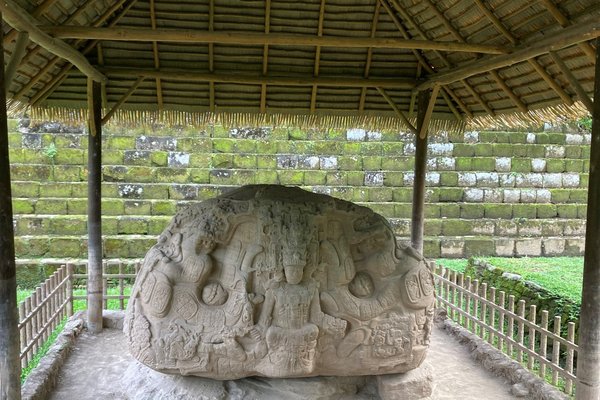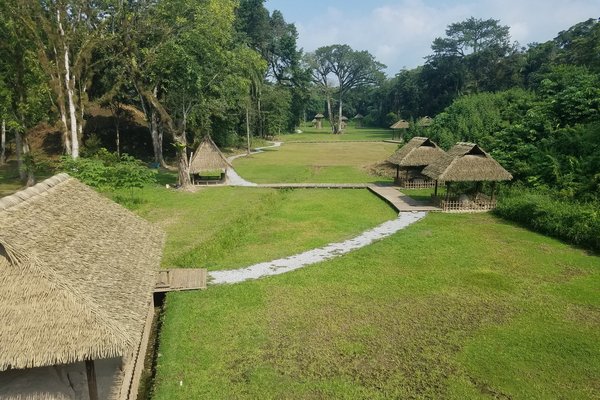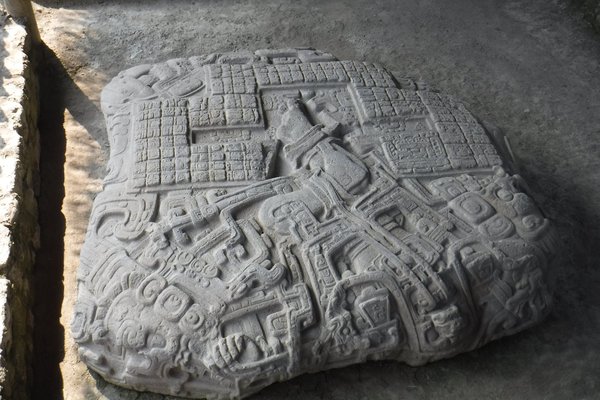Guatemala
Quirigua
The Archaeological Park and Ruins of Quirigua comprise an ancient Maya site renowned for its outstanding carved stone stelae.
The monuments centered around the Great Plaza are remarkable for their complexity and the artistic skill shown in the sculptures. Their hieroglyphic texts and sculpted calendars are an essential source for the study of Mayan history and culture. Quirigua in the 8th century was an administrative center and monuments were erected marking the end of five-year periods.
Community Perspective: a small site, but the stelae and sculptures are in exquisite condition. The surroundings with numerous birds and working banana plantations are pleasant as well.
Site Info
Official Information
- Full Name
- Archaeological Park and Ruins of Quirigua (ID: 149)
- Country
- Guatemala
- Status
-
Inscribed 1981
Site history
History of Quirigua
- 1981: Inscribed
- Inscribed
- Type
- Cultural
- Criteria
- i
- ii
- iv
Links
- UNESCO
- whc.unesco.org
- Official
-
- mcd.gob.gt — Ministry of Culture
- Related
-
- en.wikipedia.org — Link
All Links
UNESCO.org
- whc.unesco.org — whc.unesco.org/
Official Website
- mcd.gob.gt — Ministry of Culture
Related Resources
- en.wikipedia.org — Link
News Article
- June 2, 2010 whc.unesco.org — Damage to the Archaeological Park and Ruins of Quirigua as a result of tropical storm Agatha
Community Information
- Community Category
- Archaeological site: Pre-Columbian
Travel Information
Recent Connections
-
Perfect Inscriptions
1981 -
Obsidian
"Quiriqua had became the capital of an … -
Historical Graffiti
Stele A has dates (among them 1881) and…
Connections of Quirigua
- Trivia
-
-
Built or owned by Americans
"in 1910, the United Fruit Company bought a large chunk of the Motagua valley, including the ruins of Quirigua, to set up banana plantations. Fortunately, United Fruit recognized the significance of the ruins and established an archaeological park around it, taking great pains to protect the site from looters, and organized the first major excavations through the Archaeological Institute of America." -
Swan songs
Guatemala 1981
-
- History
-
-
Mayan culture
The monuments of the Archaeological Park and Ruins of Quirigua are an outstanding example and the largest corpus of Maya art masterpieces. (OUV)
-
- Ecology
-
-
Obsidian
"Quiriqua had became the capital of an autonomous and prosperous state : the extraction of jade and obsidian in the upper valley of the Rio Motagua, which was tightly controlled, gave rise to a profitable goods trade with the coastal ports of the Caribbean" (AB eval) -
Liquid Mercury
Liquid Mercury and signs of burning used to extract it from cinnabar has been found buried in caches beneath some stelae. E.g "The cache from Group A (S.D. 16), the one associated with Monument 21, had been disturbed but what was left of the single vessel contained at least some shale (possibly a broken backing for a pyrite plaque or mirror), bone fragments, and streaks of cinnabar, along with its deriva¬tive, liquid mercury." Also Monument 26 - see
-
- World Heritage Process
-
-
Perfect Inscriptions
1981
-
- Human Activity
-
-
Historical Graffiti
Stele A has dates (among them 1881) and names -
Man-made Terraces
a highly elaborate system of pyramids, terraces, and staircases (AB ev) -
Cacao
Quiriguá was ideally positioned to control the trade of uncut jade, ..., as well as controlling the flow of other important commodities up and down the river such as cacao, which was produced as a local cash crop. (wiki) -
Writing systems
Contains Maya glyphs -
Locations for playing sport
2 ballcourts, one of which has been built over (wiki)
-
- Constructions
-
-
Pyramids
a highly elaborate system of pyramids, terraces, and staircases (AB ev) -
Protective Shelters
The stelae stand under thatched coverings -
Stelae
The Archaeological Park and Ruins of Quirigua contain some outstanding 8th-century monuments and an impressive series of carved stelae and sculpted calendars that constitute an essential source for the study of Mayan civilization. (OUV) -
Monumental Monoliths
Stela E: .. This enormous monolith is the largest stone ever quarried by the ancient Maya and weighs approximately 65 tons, it may even be the largest free-standing worked monolith in the New World. (wiki)
-
- WHS on Other Lists
- Timeline
-
-
Built in the 8th century
Blossomed during the reign of Cauac Sky (723-84)
-
- Science and Technology
-
-
Astronomy and Astrology
Stelae with Mayan calendarsSee en.wikipedia.org
-
- Visiting conditions
-
-
Foreigner prices
Q20 for locals, Q80 for foreigners
-
News
- whc.unesco.org 06/02/2010
- Damage to the Archaeological Park …
Recent Visitors
Visitors of Quirigua
- Alejandro Lau
- Ali Zingstra
- A. Mehmet Haksever
- Artur Anuszewski
- Atila Ege
- Bamse
- basementonline
- Bram de Bruin
- Carlos Sotelo
- Cheryl
- Christoph
- Clyde
- Daniela Hohmann
- dave wood
- Don Irwin
- Els Slots
- Eric Lurio
- Erik Jelinek
- Eva Kisgyorgy
- Feldhase
- Frédéric M
- Gary Arndt
- H Beswick
- Iain Jackson
- Jarek Pokrzywnicki
- Javier
- Jens
- João Aender
- John Smaranda
- jonathanfr
- Justin Rickey
- Kasper
- KentishTownRocks
- Little Lauren Travels
- Loic Pedras
- Lucas Del Puppo
- Lucio
- Luis Filipe Gaspar
- Mahuhe
- Martin
- Michael Ayers
- MichaelH
- Michael Novins
- Miguel Marquez
- Milan Jirasek
- Morodhi
- natlefebvre@hotmail.
- Nihal Ege
- PabloNorte
- Patrik
- Paul Schofield
- Philipp Leu
- Pincze
- Reza
- Rick Ohm
- RobRos
- Roger Ourset
- Roman Bruehwiler
- Samy G
- Slavi
- Solivagant
- Szabo Viktoria
- Tamara Ratz
- Thomas Buechler
- Westwards
- Zoë Sheng
Community Reviews
Show full reviews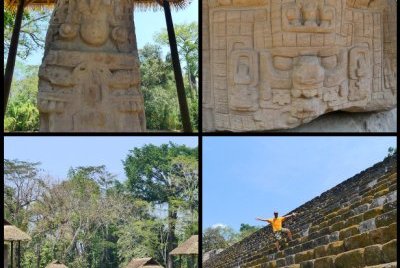
I visited this WHS in Spring 2024 as a detour from Antigua Guatemala before heading to Copan, Honduras. It is rightly famous for its superbly carved and preserved sandstone stelae, 9 of which are protected only by thatched roofs. There are small information boards in front of each stele with hieroglyphic texts and sculpted calendars. The huge trees full of birds surrounding the current site of Quirigua are a mere reminder of the jungle which used to cover these stelae. Old photos of the site can be seen in the small on-site museum, together with photos of the recent flooding. The wooden UNESCO WHS plaque has been changed with another carved one recently.
Stelae A and C are nicknamed as the Creation Stones as they describe the Mayan Creation Myth in about 4 metres of sandstone. Stela K features Quiriguá's last ruler dressed in full regalia, while Stele D depicts Cauac Sky with his unusual beard, who was the most prolific and powerful ruler in Quirigua's history. Stela E is the largest monolithic monument ever erected in the New World and is 10.6 metres tall, with 3 metres of it sunk beneath the ground to hold it upright. Stela I is incredibly ornate and remarkably different from the other stelae in almost every respect. It is of little surprise that it was created by one of the last rulers, Jade Sky. Stela H is most unusual with diagonal date glyphs in groups of four. Another highlight is the Zoomorph …
Keep reading 0 comments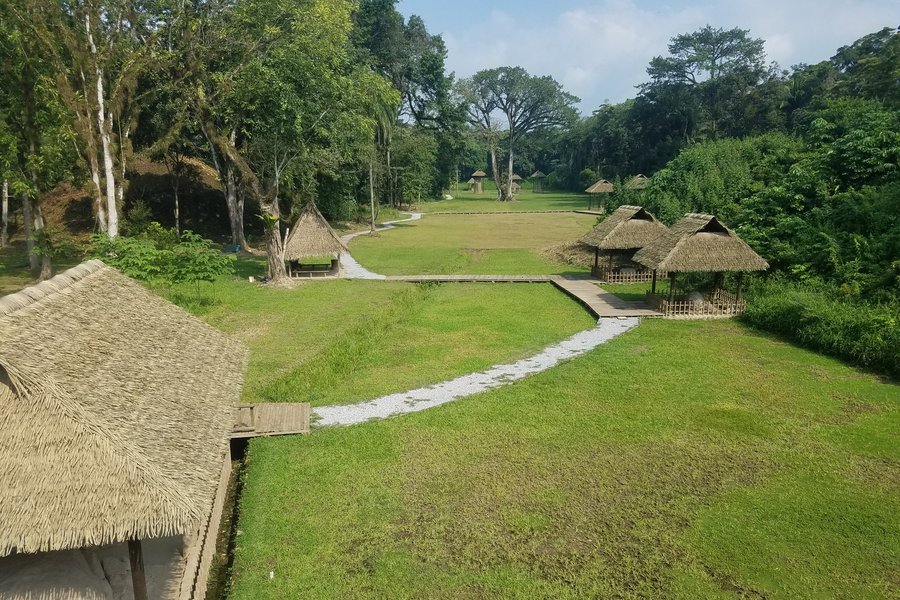
I visited Quirigua during my trip to Guatemala in November and December 2021. I visited the site on my way from the town of Chiquimula (base for visiting Copán) to my waterfront hostel in Rio Dulce (Castillo de San Felipe de Lara is nearby). The bus from Chiquimula left me directly at the intersection of the main road and the path to the ruins, where I was able to catch a tuk-tuk to the site. I left my luggage at the reception and set off to explore the ruins.
Quirigua is rather small and can be visited quickly (I spent just over an hour there, taking my time and stopping frequently to try to identify the birds singing in the forest). Nevertheless, it contains treasures of Mayan art and culture. If their architecture and grandiose urbanism can be admired elsewhere, there is no better place than Quirigua and Copán to appreciate their stelae, sculptures and statues. The works in Quirigua are all protected by thatched roofs. This is wonderful for their preservation, but it creates shadows and backlighting that are difficult to manage for photos when the sun is shining.
Stela E (photo) rises 8 meters above the ground, weighs 60 tons and is the largest stela in the Maya world. The dozen other stelae are not to be missed, however, as are the gigantic zoomorphic sculptures. A monumental ceiba, the sacred tree of the Maya, stands in the middle of the Gran Plaza. At the far end, …
Keep reading 0 comments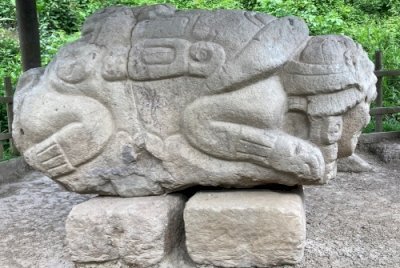
This site hasn’t been reviewed for 13 years, so I think Quiriguá deserves to be put into the spotlights. With this visit, I also completed the list of 9 WHS connected to Mayan culture. And every time you think: “I’ve seen so many Maya sites already, what can this one possibly add?” But they all have different qualities. Quiriguá has the best-preserved sculptures.
The Quiriguá archaeological park has suffered severe hurricane damage from Eta and Iota in 2020 and has only reopened in June 2021. They had to remove 12 swimming pools full of mud and water, which left certain areas flooded up to 1.8m.
During my visit in February 2022, nothing of that damage was visible anymore and the site looked very well cared for. At the entrance, you get a site-specific ticket and a booklet in English (both rare in Mexico or Central America). Signage is in both Spanish and English. There is a (new?) boardwalk that takes you along the monuments, so you don’t have to walk on the grass. It had been raining for 2 hours before my visit, and the ground had turned soggy again.
The site comprises a plaza where the sculptures have been resurrected and an acropolis with a few ruined buildings and a ball court. Parts of the site are also unexcavated, you can see unnatural hills where something must be hidden underneath. The sculptures often had fallen down or were broken when they were rediscovered in the …
Keep reading 0 comments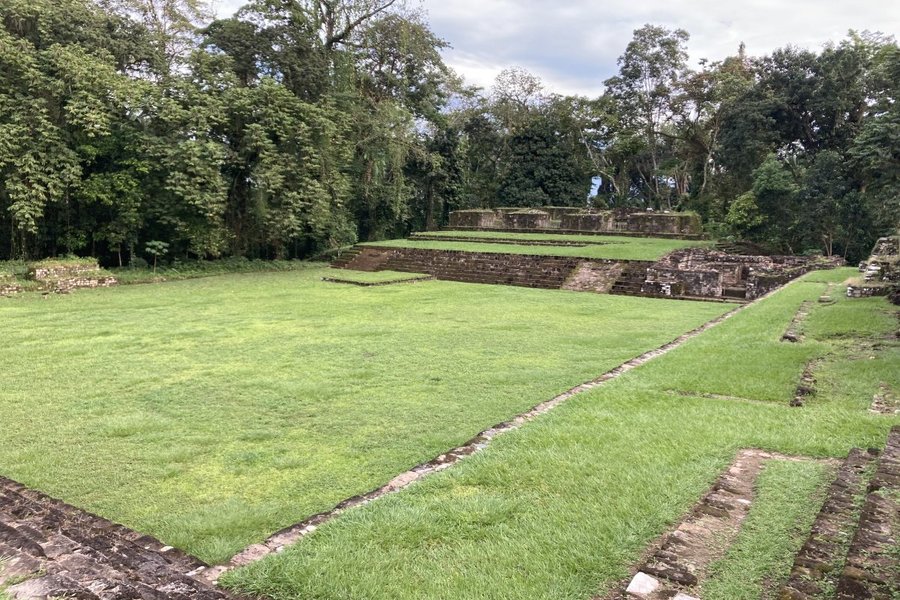
I appreciate the way the various organizations that could have ruined Quirigua have preserved and beautified the site. It was a thrill for me to climb the large stone temple building and look back at those magnificent, tall, twisted trees surrounding the large carvings. I have been interested in the Mayan mystery ever since teaching 7th and 8th grade history in the 1980's. I am increasingly convinced that the people who built these incredible stone cities came from Egypt, probably on the reed boats. The building technique is so similar to the early Egyptian "step" pyramids.
Keep reading 0 comments
I was in Bananera in, I think 1970, looking into the construction of worker housing. We were taken on hand-driven rail cars to the Quirigua site. One entered via a long tunnel through the jungle and suddenly exited onto the site. A breathless experience going from the dense jungle canopy unto this field of giant stelae. The field was quite well maintained. Some other excavations seemed to be in progress, but by whom? The United Fruit Company maintained the entrance and the grassy area where the stelae were, but were not involved with the excavations. The descriptions elsewhere on this site conform to mine. We went two or three times, but we met but one American backpacker. It is not Tikal, but the stelae are wonderful, indeed.
Keep reading 0 comments
As an archaeologist, I found Quirigua interesting, but I do not recommend it to tourists. Stop if you happen to be passing by, and check out the tallest of all the Maya stelae and some cool zoomorphic sculptures. However, don't expect much else - the site is tiny, the environment is extremely muggy, and the artwork is a lower-quality knock-off of that at nearby Copan, Honduras. Definitely, definitely, definitely visit Copan! Copan and Tikal are the two Maya sites everyone should visit, in my opinion.
Keep reading 0 comments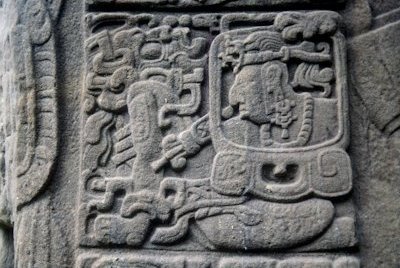
The ruins of Quirigua in Guatemala do not in any way compare with those of the “nearby” Mayan cities of Tikal and Copan or of those in Yucatan such as Palenque, Chichen Itza and Uxmal. Its main advantage is its relatively easy access from Guatemala City 220 kms away on the main highway to Puerto Barrios. If you have the time or are passing relatively near by on your way to Copan (with which Quirugia was closely associated culturally) or the coast then it is certainly worth the slight detour to take in this WHS.
Its main “glory” lies in the collection of “stelae”, 9 of which are laid out around a “football field sized” central grass plaza. The remainder of the city, which dates from 8th century is largely un-restored, so you will not see the profusion of ball courts and pyramids of other Mayan cities. The stelae are however considered the finest examples of Mayan carving anywhere and, because of the hardness of the local sandstone (elsewhere the Mayans tended to use limestone), have been preserved in amazing detail
Keep reading 0 comments
